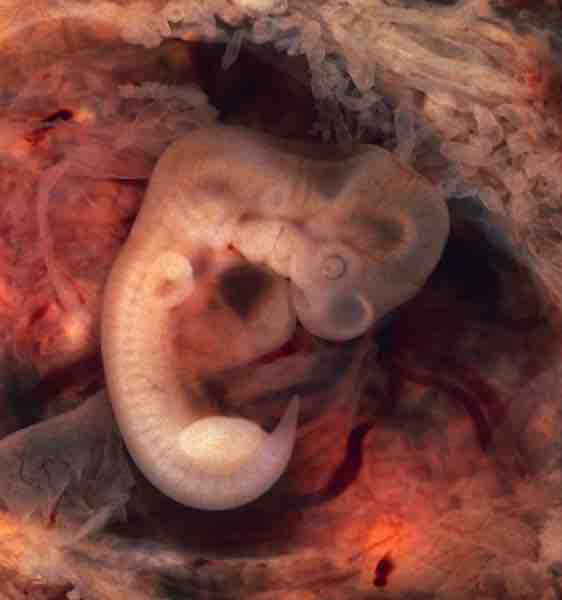Weeks five through eight of gestation are characterized by the development of the major organ systems, including the circulatory, nervous, lymphatic, and gastrointestinal systems. During this time, the embryo is extremely susceptible to the effects of teratogens.
Gestational age is the time that has passed since the onset of the last menstruation, which occurs two weeks before the actual fertilization. Embryonic age measures the actual age of the embryo or fetus from the time of fertilization. Thus, the first week of embryonic age is already week three counting with gestational age. The number of the week (used here) is one more than the actual age of the embryo/fetus. For example, the embryo is 0 whole weeks old during the first week after fertilization.
Week 5
At week five, the brain, spinal cord, vertebrae, heart, vasculature, and gastrointestinal tract begin to develop.
Week 6–7
During weeks six and seven, the embryo grows from four millimeters in length to nine millimeters and begins to curve into a C-shape . The fetal heart bulges, develops further, and begins to beat in a regular rhythm. Rudimentary blood begins to move through the main embryonic blood vessels, connecting to the yolk sac and the chorionic membrane of the placenta.
The arm and leg buds, which will grow into the full limbs over the rest of development, become visible. The neural tube, which forms the brain, closes. The brain then develops into five areas and some cranial nerves are visible.
The eyes, mouth, and ear structures begin to form. The initial differentiation of the tissues that will become the spleen, gallbladder, pancreas, liver, kidneys, stomach, and lungs occurs.

Human embryo at seven weeks
An embryo from an ectopic pregnancy, still in the oviduct. This embryo is about five weeks old (or from the seventh week of menstrual age). The heart is the dark spot at the center of the image, bulging out of the embryo.
Week 8
By week eight of gestation, the embryo measures 13 millimeters in length. The lungs begin to form, as well as the lymphatic system. The main development of the external genitalia begins, and the brain continues to develop.
The arms and legs have grown longer, and the foot and hand areas can be clearly distinguished. The hands and feet have fingers and toes, but may still be webbed.
Human embryo from an ectopic pregnancy
An embryo from an ectopic pregnancy, located in the part of the uterus to which the fallopian tube is attached. The features are consistent with a developmental age of seven weeks (the ninth week of menstrual age).